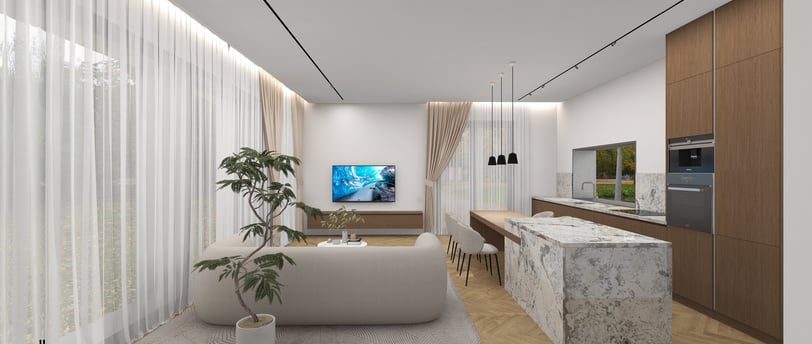The 10 Key Parts of Interior Design (Plus Floor, Wall & Ceiling Tips)
Learn the essential elements of interior design — from space, color and light to how floors, walls and ceilings shape a room. Get practical tips and creative ideas for every layer of your home.
5/26/20253 min read


Creating a stylish and functional home isn't just about picking pretty furniture — it's about understanding the essential parts of interior design. Whether you're redesigning your kitchen, revamping your living room, or planning a new home altogether, knowing the building blocks of interior design can help you make smarter decisions, save money and create a space you truly love.
In this blog post, we’ll break down the key parts of interior design and how they all come together to form a cohesive, comfortable and beautiful home.
1. Space: The Foundation of Design
Space is the starting point for any interior project. It includes the physical dimensions of a room — length, width and height — as well as how the space is used.
Positive space: Areas with furniture and decor.
Negative space: Empty areas that allow the room to "breathe."
Tip: Balance is key. Too much furniture clutters a room, while too little can make it feel empty or cold.
2. Levels of Interior Design: Floor, Walls, and Ceiling
Interior design is often solved in three physical levels: the floor, the walls and the ceiling. Each has its own role and requires a different approach.
Floor
Floors vary depending on the room’s purpose. In bathrooms and kitchens, tiles are a popular, water-resistant choice. In living rooms and bedrooms, you’ll often see wooden parquet, laminate or carpet.
Furniture and rugs significantly influence how a floor looks and functions — rugs can zone areas, add comfort and contribute to sound insulation.
Walls
Walls not only separate spaces — they also hold windows, doors, curtains and furniture. Materials and finishes may vary depending on the room's use, but the biggest design challenge is often dealing with empty wall space.
This is one of the most creative and tricky areas in interior design. From art to shelving, paint to wallpaper, wall décor is a powerful tool to express personal style.
Ceilings
Ceilings are usually simpler to solve, but they still play a vital role. Unique architectural shapes, thoughtful lighting, or integrated technology (like built-in speakers or hidden climate systems) can elevate a room’s atmosphere and finish the design beautifully.
3. Line: The Silent Organizer
Lines guide the eye and structure a space. There are three main types:
Horizontal lines (tables, shelves): Create calm and stability.
Vertical lines (windows, door frames): Add height and elegance.
Dynamic lines (staircases, angled ceilings): Bring energy and movement.
Using a mix of these creates interest and harmony.
4. Form: The Shape of Things
Form refers to the shape of furniture, decor and architectural features. It can be:
Geometric (sharp and structured, like squares or rectangles)
Organic (natural and flowing, like curved sofas or plants)
Repeating forms and avoiding clashes in style help keep a design cohesive.
5. Light: The Game Changer
Lighting transforms a space — visually and emotionally.
Natural light: Sunlight through windows, skylights.
Artificial light: Ceiling lights, lamps, under-cabinet lighting.
Task lighting: Functional, like reading lights.
Ambient lighting: General lighting for the whole room.
Accent lighting: Highlights art, decor or architectural details.
Tip: Layer your lighting to make the space both functional and inviting.
6. Color: Emotion in a Can
Color is powerful — it sets mood, influences perception and reflects personality.
Warm colors (reds, oranges, yellows): Cozy, energetic.
Cool colors (blues, greens, purples): Calm, refreshing.
Neutrals (white, gray, beige): Versatile, timeless.
Use color strategically in walls, furniture, textiles and accents.
7. Texture: The Tactile Layer
Texture adds depth and interest. It’s how surfaces look and feel — smooth, rough, soft, glossy.
Hard textures: Metal, glass, stone.
Soft textures: Fabrics, rugs, cushions.
Combining different textures keeps a room from feeling flat or sterile.
8. Pattern: The Personality Boost
Patterns bring life and movement to a design. They appear in wallpaper, textiles, rugs, tiles and more.
Floral and organic: Soft, natural vibe.
Geometric: Bold, modern look.
Abstract: Artistic and unique.
Use patterns sparingly or boldly depending on your style.
9. Furniture & Fixtures: Function Meets Style
The right furniture layout can maximize both comfort and flow. Focus on:
Proportions: Choose pieces that suit your room size.
Functionality: Consider how you use the space daily.
Placement: Arrange to support conversation, movement and purpose.
Fixtures like lighting, built-ins and cabinetry play a big role in fixed functionality.
10. Accessories: The Final Touch
Accessories are what give a room its soul — think artwork, plants, cushions, books, candles and mirrors.
They should:
Complement your color scheme
Reflect your personal style
Avoid visual clutter
Less is often more.
Final Thoughts
Interior design is both an art and a science. By understanding key principles — space, structure, color, lighting, texture — and the physical layers of design like floor, walls, and ceiling, you can create a home that is visually balanced, highly functional and truly personalized.
Explore furniture trends and interior inspiration today.
Contacts
Home
+370 615 41018
© 2025. All rights reserved.
